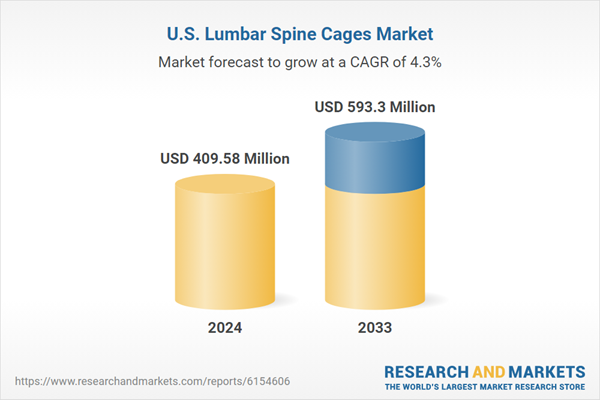According to WHO estimates, around 15.4 million people worldwide were diagnosed with or are living with spinal cord injuries as of April 2024. Such injuries occur due to spinal nerve compression or damage, affecting the vertebral column's outer side. The primary causes of this compression include spinal degeneration, bone fractures, and various abnormalities. The growth of the market is fueled by the increasing incidence of spinal cord injuries (SCIs) across the globe.
The increasing elderly population, along with a rise in obesity rates, often results in various spinal conditions, including spinal stenosis. This situation boosts the demand for spinal surgeries, contributing to market growth. For example, a study published by the JAMA Network in May 2022 highlighted that lumbar spinal stenosis affects approximately 11% of the older population in the
U.S. Research shows that about 20% of people over 60 exhibit signs of spinal stenosis on imaging examinations. Notably, more than 80% of these cases are asymptomatic and do not require treatment. In addition, obesity is linked to severe lower back issues and raises the risk of recurrence, leading to increased use of spinal devices in healthcare. Spine-related ailments, including degenerative disc diseases, vertebral compression fractures, spondylolisthesis, and spinal stenosis, significantly impact the elderly.
Moreover, the demand for minimally invasive procedures is growing as these procedures result in less trauma & quicker recovery than invasive ones. As the recovery time is shorter, patients’ hospital stay is reduced, resulting in lower costs associated with surgery & hospital stay. For instance, XLIF (Extreme Lateral) and DLIF (Direct Lateral Interbody Fusion) are minimally invasive spine surgeries that access the spine from the side of the body. These approaches allow for lumbar cage placement with smaller incisions, less muscle disruption, and faster recovery. They are commonly used for treating degenerative disc disease and spinal instability. Owing to the following factors, minimally invasive surgeries are replacing open/invasive surgeries:
- Fewer incision wounds lead to higher patient satisfaction
- Economically viable due to the short duration of hospital stays
- Fewer cases of postsurgical complications and low mortality
Moreover, a rise in investments to accelerate advancements in spinal surgeries fuels the market growth. For instance, in September 2024, Neo Medical SA (Neo), a MedTech company, received USD 68 million in a Series B financing round led by Gyrus Capital SA (Gyrus) to accelerate its global growth in spine surgery. This investment aims to increase Neo’s market share in strategic regions, with an immediate focus on expanding its presence in the U.S. market. Similarly, in August 2024, Spineology, a medical device company, secured USD 25 million in a Series AA funding round led by SV Health Investors. 1315 Capital and existing investor RC Capital also participated.
U.S. Lumbar Spine Cages Market Report Segmentation
This report forecasts revenue growth at the country level and provides an analysis of industry trends in each of the sub segments from 2021 to 2033. For this study, Grand View Research, Inc. has segmented the U.S. lumbar spine cages market report based on cage design, approach/technique, reconstruction, and material:Cage Design Outlook (Revenue, USD Million, 2021 - 2033)
- Static Cages
- Expandable Cages
Approach/Technique Outlook (Revenue, USD Million, 2021 - 2033)
- TLIF (Transforaminal Lumbar Interbody Fusion) Cages
- PLIF (Posterior Lumbar Interbody Fusion) Cages
- ALIF (Anterior Lumbar Interbody Fusion) Cages
- XLIF (Extreme Lateral Interbody Fusion) Cages
- OLIF (Oblique Lumbar Interbody Fusion) Cages
Reconstruction Outlook (Revenue, USD Million, 2021 - 2033)
- Vertebrectomy Cages
- Corpectomy Cages
Material Outlook (Revenue, USD Million, 2021 - 2033)
- PEEK (Polyether ether ketone)
- Titanium
- Carbon Fiber Reinforced Polymer (CFRP)
- Other Biocompatible Materials
Why should you buy this report?
- Comprehensive Market Analysis: Gain detailed insights into the global market across major regions and segments.
- Competitive Landscape: Explore the market presence of key players worldwide.
- Future Trends: Discover the pivotal trends and drivers shaping the future of the global market.
- Actionable Recommendations: Utilize insights to uncover new revenue streams and guide strategic business decisions.
This report addresses:
- Market intelligence to enable effective decision-making
- Market estimates and forecasts from 2018 to 2030
- Growth opportunities and trend analyses
- Segment and regional revenue forecasts for market assessment
- Competition strategy and market share analysis
- Product innovation listing for you to stay ahead of the curve
- COVID-19's impact and how to sustain in these fast-evolving markets
This product will be delivered within 1-3 business days.
Table of Contents
Companies Mentioned
- Medtronic
- DePuy Synthes (J&J)
- Stryker
- Zimmer Biomet
- Globus Medical
- ATEC Spine
- Aurora Spine
- Medacta International
- ORTHOFIX MEDICAL INC.
- XTANT MEDICAL HOLDINGS, INC.
Table Information
| Report Attribute | Details |
|---|---|
| No. of Pages | 100 |
| Published | July 2025 |
| Forecast Period | 2024 - 2033 |
| Estimated Market Value ( USD | $ 409.58 Million |
| Forecasted Market Value ( USD | $ 593.3 Million |
| Compound Annual Growth Rate | 4.2% |
| Regions Covered | United States |
| No. of Companies Mentioned | 10 |









